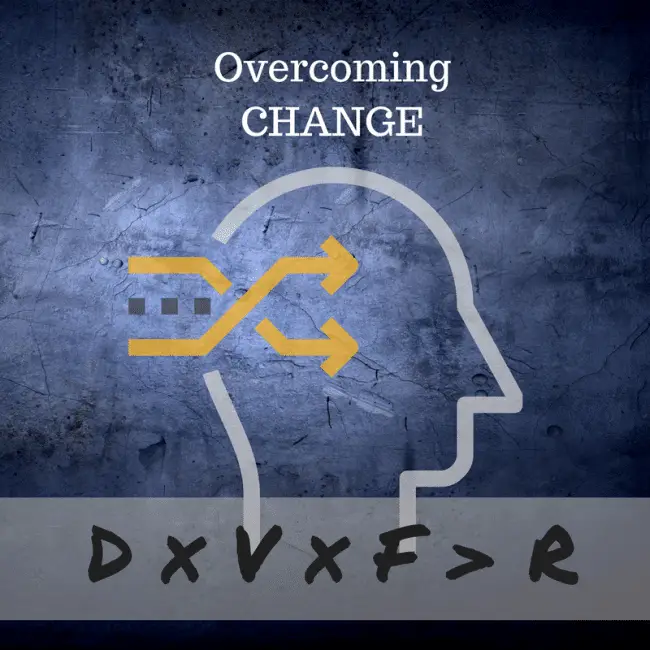
Business leaders know the challenge it can be to lead change. When there is a new announcement about something changing, you can often hear the groans that arise.

Work teams of all kinds resist change. Understanding ways to overcome the resistance can be a leader’ s best answer in times of change.
As I’ve mentioned before, managing change can be very darn difficult. Within the body of change management that is so readily available, much has been written about overcoming resistance to change. I have found one particular explanation for ways to overcome the resistance, that makes things crystal clear.
In the 1960’s David Gleicher put forth a comprehensive explanation of the theory of change. Others after him altered his work slightly but gave credit to him as the creator of this view. Here’s what Gleicher said.
Three factors must be present for meaningful organizational change to take place. A formula for overcoming resistance to change looks like this:
D x V x F > R
These factors are:
D= Dissatisfaction with how things are now;
V= Vision of what is possible
F= The First, concrete steps that can be taken towards the vision;
By multiplying these three factors, if the product is greater than Resistance, then change is possible.
Because D, V, and F are multiplied, if any one of the factors is absent (zero) or low, then the product will be zero or low and therefore not capable of overcoming the resistance.
To ensure a successful change it is necessary to use influence and strategic thinking in order to create a vision and identify those crucial, early steps towards it. In addition, the organization must recognize and accept the dissatisfaction that exists by listening to the employee voice while sharing industry trends, leadership best practices and competitor analysis to identify the necessity for change.
Dissatisfaction – When dissatisfaction with the current state is present, change can be easier. We deal with these kinds of change every day. If the temperature is too cold, we turn on the heat. If it’s too hot, we turn on a fan or an air conditioner to cool us. In these simple examples, resistance to change is practically zero because the dissatisfaction is so high.
In a job setting the dissatisfaction is harder to identify and measure. If your team’s computers are getting old and outdated, they perform poorly. Sometimes they freeze. The need for change can be obvious. So you offer a chance to upgrade Technology. Resistance might be low.
However, when you change a computer system seeking some other goal, the work team may resist that change. When the perception is things are working well, a change can see a greater resistance because dissatisfaction is low.
Vision – The leader’s ability to paint the best vision picture can be one of the greatest strengths. People can and do rally around a good vision for the future; a look at what could be. You can be operating with very little dissatisfaction, but have a vision for something greater and still overcome resistance to the change.
Mergers and reorganizations come to mind. The leadership sees an opportunity for something much greater so an announcement is made about reorganizing or merging entities. The natural response from the staff is resistance. Yet when the vision is presented well, with great conviction and quantifiable gains for everyone, the resistance can be overcome.
Forgetting to add the proper vision when driving change can create the zero value in this DVF>R equation, thus making resistance too great to overcome.
First Steps – Being able to reduce resistance can actually be easier than we think. Taking solid, specific first steps toward the change can create the momentum you need to break through the resistance and effect change.
The first steps are often forgotten as critical to successful change. The big transformation project gets mapped out, but the first steps are merely buried in the details with little if any focus and intention.
Successfully managing change requires focused effort to get the first steps right. Again, having zero impact with first steps could negate the whole equation, keeping resistance high, keeping change from happening.
When you are faced with a leadership challenge for change, think about this simple formula. Review the three elements present in your own situation. Do what you can to enhance and control the factors so that your ability to eliminate resistance is effective.
Once the resistance goes way or at least gets minimized, you have a much greater chance of making change happen.
Think about your own experience managing change. Test this theory and review where the gaps occurred. I think you will find the model holds true. Focus on the three components described here and you will greatly increase your own effectiveness leading change.
What do you do to overcome any resistance to change? Share, leave a comment.
Originally posted on DougThorpe.com
If you enjoyed reading this article, please recommend and share it to help others find it!
Call To Action
If you want to increase your influence as a manager, business owner, or community leader and learn some valuable life hacks, then subscribe to my private mailing list.
Click here to subscribe right now!
The post Leading Change: An Old Model Reveals New Ideas appeared first on Business Advisor and Executive Coach | Doug Thorpe.
Notifications